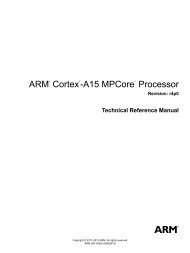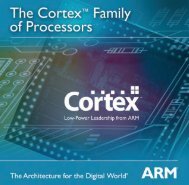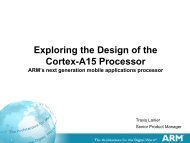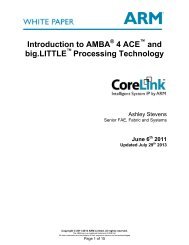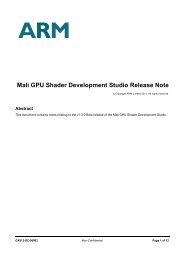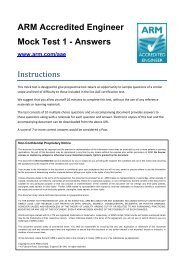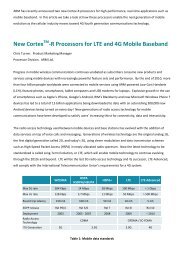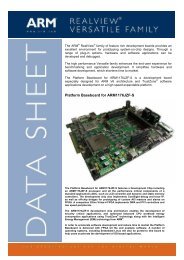Introducing the ARM Cortex-M0+ processor: The Ultimate in Low ...
Introducing the ARM Cortex-M0+ processor: The Ultimate in Low ...
Introducing the ARM Cortex-M0+ processor: The Ultimate in Low ...
- No tags were found...
Create successful ePaper yourself
Turn your PDF publications into a flip-book with our unique Google optimized e-Paper software.
In addition, <strong>the</strong> <strong>Cortex</strong>-<strong>M0+</strong> <strong>processor</strong> supports vector table relocation, just like <strong>the</strong> <strong>Cortex</strong>-M3 and<strong>Cortex</strong>-M4 <strong>processor</strong>s. This allows easy reassignment of exception vectors at run time. All <strong>the</strong>se featuresare configurable options for silicon designers. In its m<strong>in</strong>imum configuration <strong>the</strong> silicon area of <strong>the</strong> <strong>Cortex</strong>-<strong>M0+</strong> <strong>processor</strong> is <strong>the</strong> same as <strong>the</strong> <strong>Cortex</strong>-M0 <strong>processor</strong>.For some silicon designers, more good news is that <strong>the</strong>y can very easily use <strong>the</strong> <strong>Cortex</strong>-<strong>M0+</strong> <strong>processor</strong>with 16-bit Flash memories with m<strong>in</strong>imal impact to <strong>the</strong> performance or <strong>the</strong> system design. <strong>The</strong> <strong>Cortex</strong>-<strong>M0+</strong> <strong>processor</strong> can be configured to generate <strong>in</strong>struction fetches as 16-bit ra<strong>the</strong>r than 32-bit accesses.Because most of <strong>the</strong> <strong>in</strong>structions <strong>in</strong> <strong>the</strong> <strong>ARM</strong>v6-M architecture are 16-bit, <strong>the</strong> system can still run withvery good performance.This focus on ma<strong>in</strong>ta<strong>in</strong><strong>in</strong>g a very low silicon area allows our partners to conceive size optimized solutionsthat address consumer and safety markets such as small sensors/actuators <strong>in</strong> factory automation,automotive and medical.Debug<strong>The</strong>re are also new features <strong>in</strong> <strong>the</strong> debug support. Beside <strong>the</strong> debug features <strong>in</strong> <strong>the</strong> exist<strong>in</strong>g <strong>Cortex</strong>-M0<strong>processor</strong>, <strong>the</strong> <strong>Cortex</strong>-<strong>M0+</strong> <strong>processor</strong> supports a Micro Trace Buffer (MTB) which provides simple<strong>in</strong>struction trace. <strong>The</strong> programmer allocates a small part of <strong>the</strong> system SRAM as a trace buffer and <strong>the</strong>MTB stores <strong>in</strong>struction flow <strong>in</strong>formation to <strong>the</strong> reserved SRAM as a circular buffer. After <strong>the</strong> <strong>processor</strong> ishalted, for example due to a breakpo<strong>in</strong>t, <strong>the</strong> debugger can <strong>the</strong>n retrieve <strong>the</strong> trace <strong>in</strong>formation via <strong>the</strong>widely adopted Serial Wire Debug (SWD) connection – this needs only two p<strong>in</strong>s – and <strong>the</strong>n reconstruct<strong>the</strong> recent execution history. <strong>The</strong> MTB can also support “one-shot” trigger<strong>in</strong>g.Figure 4 Instruction Trace support via MTB, already fully supported <strong>in</strong> Keil MDK-<strong>ARM</strong>Copyright © 2012 <strong>ARM</strong> Limited. All rights reserved.<strong>The</strong> <strong>ARM</strong> logo is a registered trademark of <strong>ARM</strong> Ltd.All o<strong>the</strong>r trademarks are <strong>the</strong> property of <strong>the</strong>ir respective owners and are acknowledgedPage 4 of 5



